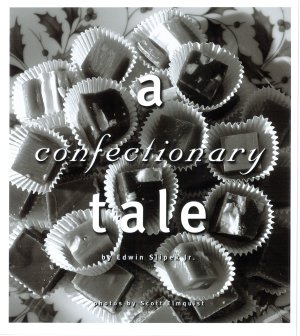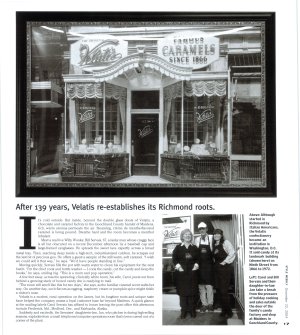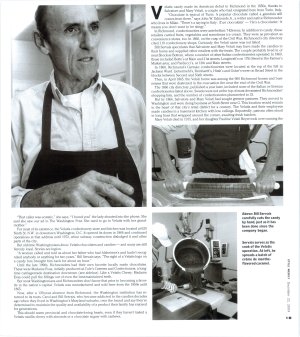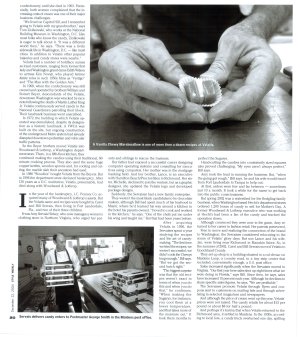Meet a real live Willy Wonka: Bill Servais, 67, a lanky man whose craggy face is all but obscured on a recent December afternoon by a baseball cap and large-framed eyeglasses. He spreads the sweet lava expertly across a broad metal tray. Then, reaching deep inside a high-tech, industrial-sized caldron, he scrapes out the last bit of precious goo. He offers a guest a sample of the still warm, soft caramel. “I wish we could sell it that way,” he says. “We’d have people standing in line.”
Moving quickly, Servais fills the pot with warm water to clean his equipment for the next batch. “I’m the chief cook and bottle washer — I cook the candy, cut the candy and keep the books,” he says, smiling big. “This is a mom and pop operation.”
A few feet away, across the sprawling, clinically white room, his wife, Carol, peers out from behind a growing stack of boxed candy she is readying to mail.
“The room will smell like this for two days,” she says, as the familiar caramel scent wafts her way. On another day, such flavors as eggnog, raspberry cream or pumpkin spice might tickle a visitor’s nose.
Velatis is a modest, rural operation on the James, but its longtime roots and unique taste have helped the company amass a loyal customer base far beyond Maidens. A quick glance at the mailing labels Carol Servais has affixed to boxes leaving the post office this afternoon include Frederick, Md., Medford, Ore., and Fairbanks, Alaska.
Suddenly and excitedly, the Servaises’ daughter-in-law, Jan, who pitches in during high-selling seasons, explodes from a small telephone/computer operations room that’s been carved out of a corner of the plant.
“That caller was ecstatic,” she says, “‘I found you!’ the lady shouted into the phone. She said she saw our ad in The Washington Post. She used to go to Velatis with her grandmother.”
For most of its existence, the Velatis confectionery store and kitchen was located at 620 Ninth St. N.W. in downtown Washington, D.C. It opened its doors in 1866 and continued operations at that address until 1972, when subway construction dislodged it and other parts of the city.
But old-time Washingtonians know Velatis chocolates and candies — and many are still fiercely loyal. Stories are legion.
“A woman called and told us about her father who had Alzheimer’s and hadn’t recognized anybody or anything for two years,” Bill Servais says. “The sight of a Velatis logo on a candy box brought him back for about an hour.”
Until the late 1990s, Richmonders had their own favorite locally made chocolates. These were Madame Evas, initially produced at Cole’s Caterers and Confectioners, a longtime carriage-trade destination downtown (see sidebar). Like a Velatis Chewy, Madame Evas could pull the fillings out of even the best-maintained teeth.
But most Washingtonians and Richmonders don’t know that prior to becoming a favorite in the nation’s capital, Velatis was manufactured and sold here from the 1850s until 1865.
Now, after a 139-year absence from Richmond, the Washington institution has returned to its roots. Carol and Bill Servais, who became addicted to the candies decades ago when they lived in Washington’s Maryland suburbs, own the brand and say they’re determined to maintain the quality and availability of a product their family has enjoyed for generations.
This should warm provincial and chocolate-loving hearts, even if they haven’t tasted a Velatis vanilla chewy with almonds or a chocolate sugary with cashews.
Velatis candy made its American debut in Richmond in the 1850s, thanks to Salvatore and Mary Velati, a couple who had emigrated here from Turin, Italy.
“Chocolate is typical of Turin. A popular chocolate called a gianduia still comes from there,” says John W. Edmonds Jr., a writer and native Richmonder who lives in Milan. “There’s a saying in Italy: ‘E un cioccolatai’ — ‘He’s a chocolatier.’ It means you don’t want to be stingy.”
In Richmond, confectioneries were antebellum 7-Elevens. In addition to candy, these retailers carried fruits, vegetables and sometimes ice cream. They were as prevalent as convenience stores, too. In 1860, on the cusp of the Civil War, Richmond’s city directory cited 110 confectionery shops. Curiously, the Velati name was not listed.
Bill Servais speculates that Salvatore and Mary Velati may have made the candies in their home and supplied other retailers with the treats. The couple probably lived in or near Shockoe Bottom, where a number of other Italian confectioneries operated. In 1860, those included Botto’s at Main and 21st streets; Longinotti’s on 17th Street in the Farmer’s Market area; and Parducci’s, at 12th and Main streets.
In 1860, Richmond’s German confectioneries were located at the top of the hill in Jackson Ward. Liebermehl’s, Reinhardt’s, Hirsh’s and Gotze’s were on Broad Street in the blocks between Second and Sixth streets.
Then, in April 1865, the Velati home was among the 900 Richmond homes and businesses that were destroyed in the evacuation fire near the end of the Civil War.
The 1866 city directory, published a year later, included none of the Italian or German confectioneries listed above. Sweets were not at the top of most devastated Richmonders’ shopping lists, and the number of confectioneries plummeted to 33.
But by 1866, Salvatore and Mary Velati had sought greener pastures. They moved to Washington and were doing business at Ninth Street near G. This location would remain in the heart of that city’s retail district for a century. The Velatis and their employees made candies in a basement kitchen with low ceilings. Reportedly, patrons often stood in long lines that wrapped around the corner, awaiting fresh batches.
Mary Velati died in 1915, and her daughter Pauline Velati Beyer took over running the confectionery until she died in 1963. Perennially, both women complained that the increasing costs of cream was one of their major business challenges.
“We lived on Capitol Hill, and I remember going to Velatis with my grandmother,” says Tom Ziolkowski, who works at the National Building Museum in Washington, D.C. Like most folks who know the candy, Ziolkowski is eager to talk about it. “It was a different world then,” he says. “There was a lively sidewalk life in Washington, D.C. — like most cities. In addition to Velatis other popular bakeries and candy stores were nearby.”
Velatis had a number of boldface names as loyal customers, ranging from former first lady and Washington grand dame Edith Wilson to actress Kim Novak, who played femme fatale roles in such 1950s films as “Vertigo” and “The Man with the Golden Arm.”
In 1968, when the confectionery was still owned and operated by brothers William and Robert Beyer, descendants of the Velatis, downtown Washington was wracked by race riots following the death of Martin Luther King Jr. Velatis continuously served candy to the National Guardsmen patrolling their block. Their landmark business went unscathed.
In 1972, the building in which Velatis operated was demolished, despite its designation as a historic landmark. A YWCA was built on the site, but ongoing construction of the underground Metro system had already disrupted downtown pedestrian and vehicular traffic patterns.
So the Beyer brothers moved Velatis into Woodward & Lothrop, a Washington department store. There, in a fifth-floor kitchen, they continued making the candies using their traditional, 80-minute cooking process. They also used the same huge copper kettles, wooden spoons and, for cooling and cutting, the marble slab their ancestors had used.
In 1980 “Woodies” bought Velatis from the Beyers. But in 1996 the department store declared bankruptcy. After 130 years as a D.C. institution, Velatis, presumably, had died along with Woodward & Lothrop.
In the year of the bankruptcy, J.C. Penney Co. acquired many of Woodward & Lothrop’s assets. But the Velatis name and recipes were bought by Carol and Bill Servais, then living in Fort Lauderdale, Fla., and two of their three children.
It was Amy Servais Hickey, who now manages a women’s clothing store in Northern Virginia, who urged her parents and siblings to rescue the business.
Her father had enjoyed a successful career designing computer operating systems and consulting for executives using computers. Her mother was in the mortgage banking field. And her brother, Lance, is an executive with Hamilton Beach/Proctor-Silex in Richmond. Her sister, Michelle, declined to join the venture, but as a graphic designer, she updated the Velatis logo and developed package designs.
Suddenly, the Servaises had a new family enterprise.
They weren’t the most likely candidates to be chocolate makers, although Bill had spent much of his boyhood in Miami, where he’d learned his way around a kitchen in the hotel his parents owned. “I loved to cook and worked in the kitchen,” he says. “One of the chefs put me under his wing and taught me.” But that had been years before.
After acquiring Velatis in 1996, the Servaises spent a year studying the recipes and the art of candy-making. “The first time we tried the recipes, we weren’t successful; we didn’t cook the Chewys long enough,” Bill says. “But we got the second batch right.”
“The biggest surprise was that the old recipes weren’t exact in terms of when you do this and when you do that,” he continues. “When making the Sugarys, for instance, you cool them at a lower temperature, and that takes more of the moisture out.” It took them months to perfect the Sugarys.
Hand-cutting the candies into consistently sized squares also proved challenging. “My eyes aren’t always perfect,” Bill says.
Amy took the lead in running the business. But, “when the going got rough,” Bill says, he and his wife would travel from Fort Lauderdale to Tampa to help out.
At first, orders were few and far between — sometimes just 10 a month. It took a while for the name to get back into the public consciousness.
But spring 2002 was a watershed for the fledgling family business, when Washington-based Hecht’s department stores ordered 1,200 boxes of candy to sell for Mother’s Day. A former Woodward & Lothrop executive who was working at Hecht’s had been a fan of the candy and tracked the operation down.
Although convinced they were now in the game, Amy returned to her career in fashion retail. Her parents persevered.
Free to move and realizing the connection of the brand to Washington, the Servaises considered relocating to the scene of Velatis’ glory days. But son Lance and his wife, Jan, were living near Richmond in Manakin Sabot. So, in the summer of 2002, Carol and Bill Servais moved Velatis to Goochland County.
They set up shop in a building situated in a cul-de-sac on Maidens Loop, a country road, in a tiny strip center that included, conveniently enough, a U.S. post office.
Sales increased significantly when the Servaises moved to Virginia. “Our first year here sales shot up eight times what we were doing in Florida,” says Bill. Since then, he says, sales have increased 15 percent each year. Although he declines to share specific sales figures, he says, “We are profitable.”
The Servaises promote Velatis through flyers and coupons sent to customers on mailing lists and through advertising in selected magazines and newspapers.
And although the price of cream went up this year, Velatis’ prices were not raised. The candy retails for about $15 per pound or about $8 for half a pound.
And perhaps it’s karma that when Velatis returned to the Richmond area, it settled in Maidens. In the 1930s, according to local lore, a candy truck overturned one day, spilling its chocolate goods. Neighbors emerged from the woodwork to scoop up the sweets. Since then, the intersection of Maidens Road and Route 6 has been called Chocolate Drop Corner. Today, those in search of a chocolate fix can find one just a few hundred yards away.
“We have reasonably low overhead, and since we live near Goochland Courthouse, the commute is unbelievable,” says Bill, “It’s really great living here. We don’t have to contend with traffic.”
During this holiday season, the Servaises may work until 10 or 11 at night to fulfill orders. They have one seasonal employee.
“But it’s kind of hard for a wife and husband to work together,” Carol admits.
“She doesn’t like the way I pack the candy,” Bill says, laughing.
“He’s supposed to stay out of my work area [which includes the retail side of the business],” she adds.
Carol and Bill agree, however, that like their predecessors in the business, the cost of cream is one of their biggest expenses. “But whatever we do has to be 100 percent,” he says, “One of my favorite compliments we’ve had is that when you put this candy in your mouth, it doesn’t crumble, it just melts.”
“We’re not in the business of selling anything less than the best,” he says. “This is a unique candy. You can’t get rid of the cream, and you can’t go to a cheaper sugar. If you added preservatives, then you’d not be Velatis.” S
Another Favorite
In 1860, the Richmond city directory listed 110 confectioneries. By 1866, the number had dwindled to 33 as the city struggled to rebuild after the Civil War.
During the 20th century, perhaps no candy company was more beloved than Cole’s. In 1909, Harry V. Cole opened his company, Cole’s Caterers and Confectioners, on 209 E. Franklin St. It moved to Grace Street in 1962 but closed in 1963.
One of Cole’s specialties was sponge sugar, candy that was hardened and then softened again, and worked by hand into fanciful leaves and flowers. It was also one of Richmond’s most popular stores for novelties and party items.
But one of Cole’s most popular candy products was its made-from-scratch Madame Evas. They were essentially balls of chocolate about the size of a quarter, with a pecan or almond embedded on top. Cole had been given the recipe by a French chef and his wife who had a confectionery shop near Central Park in Manhattan.
“Madame Evas are to chocolate, what Smithfield is to ham,” wrote former Virginian-Pilot columnist Guy Friddell, who had a popular column in the former Richmond News Leader for many years.
In 1974, Cole’s was out of business. But until the late 1990s other candy makers here produced Madame Evas. And now, Richmond-born and hand-packed Velatis Sugarys and Chewys have returned. —E.S.




